Dear reader: This article contains links to products and services that I may be compensated for, at no extra cost to you.
Fo Guang Shan (佛光山 or Foguangshan) is one of the four large Buddhist organizations in Taiwan. The order’s headquarters, Fo Guang Shan Monastery in Kaohsiung, Southern Taiwan, is one of Taiwan’s top attractions and most popular places to visit in Kaohsiung.
The enormous, sprawling Fo Guang Shan Temple complex more than doubled in size with the 2011 addition of the Fo Guang Shan Buddha Museum (pictured above), built to house a tooth relic of the Buddha. The huge and visually stunning new area includes a 108-meter seated metal Buddha, the tallest in Taiwan.
Below I’ll describe my two experiences visiting and staying at Foguangshan, with information on things to do at Fo Guang Shan, what to expect there, how to get to Foguangshan, how to do a temple stay, how to plan your Foguangshan itinerary, what to eat there, and more.
For more general information, see my guide to planning a trip to Kaohsiung.
Table of Contents
Foguangshan Useful Info
Location: Dashu Distrct (大樹區), Kaohsiung City, 20 km from Kaohsiung City Center
Entrance Fee: Free
What to wear: Although there’s no dress code and shorts are fine, it’s always respectful to dress a little more modestly when visiting a Buddhist temple.
Best guided tours from Kaohsiung: Half-Day Kaohsiung Tour and Kaohsiung Classic Sights Day Tour
Information about visiting Taiwan
Recommended Taiwan Travel Itinerary
Free TWD100 credit for travel deals in Taiwan
Fo Guang Shan Opening Hours:
Foguangshan Monastery: 8 a.m. to 5 p.m. daily
Buddha Museum & Big Buddha: 9 a.m. to 6 p.m. (to 7 p.m. weekends, closed Tuesdays)
Pilgrim’s guesthouse contact info: 07-6561921 (ext. 8100), email: [email protected] or [email protected]
Official Foguangshan Website
Buddha Museum Website
Foguangshan Hsi Lai Temple (西來寺) in California, USA
Fo Guang Shan Overview

Fo Guang Shan is as quirky as it is impressive. The older, original monastery area takes Buddhist decoration to the extreme, with tens of thousands of Buddha statues and even a super creepy “Pure Land Cave.” The older monastery section of Foguangshan is also where you’ll find the temple stay program for visitors who wish to stay overnight.
Meanwhile, the newer Buddha Museum complex features a Starbucks of its own, loads of Taiwanese vegetarian restaurants to choose from, and a system of underground palaces built to preserve artifacts as memories of human civilization. I told you things get bizarre at Foguangshan!
You’ll definitely notice that Foguangshan has a lot of wealth and isn’t afraid to show it. Besides the lavish temple grounds, you may also see monks using the latest iPhone or driving luxury cars. But it’s also important to note that the organization also does a huge amount of charity work both in Taiwan and around the world.
My Visits and Overnight Stay at Foguangshan

I had the pleasure of staying overnight at Foguangshan the first time I visited it back in 2010. This was more than a year before the Big Buddha Museum was finished being built, so only the older, original monastery grounds were open.
One of the highlights of spending the night was being able to wander the temple grounds after all the tourists had gone home in the evening and after dark. There were lights and lanterns decorating all the temples, making the entire place incredibly atmospheric.
More recently, I visited Foguangshan again to see the new Buddha Museum and Fo Guang Big Buddha.
After both visits, one thing I can say is that I left Foguangshan with more questions about this “Buddhism” and what it’s really all about than before I had arrived (and I studied Buddhism and religious studies in university!)

Awesome time to visit – In the weeks following Lunar New Year in Taiwan, Foguangshan puts up thousands of lanterns and lights for the Fo Guang Shan New Year Festival of Light and Peace. Find more info in my Taiwan Lantern Festival guide.
In recent years, the event usually starts around Lunar New Year’s Day and then continues for a whole month after, but please confirm the dates on the temple’s website. Learn more in my Taiwan festival guide.
History of Foguangshan
Taiwanese Buddhism is said to be made up for “Four Great Mountains,” or Buddhist organizations. These are Dharma Drum in the north, Tzu Chi in the east, Chung Tai Shan in the west, and Fo Guang Shan in the south.
Fo Guang Shan was founded in 1967 by the Buddhist monk Hsing Yun. Yun’s philosophy is a type of Humanistic Buddhism, characterized by integrating Buddhist practices in everyday life.
Upon founding the organization, Yun purchased 30 hectares of land in Dashu District (大樹區), southern Kaohsiung County (today the former county is called Kaohsiung City). It is located about 20 kilometers northeast of the Kaohsiung City Center.
Over the next 15 years, numerous temples, shrines, a cemetery, and a 36-meter Amitabha Buddha statue were built at Fo Guang Shan.

The organization also expanded to many other parts of Taiwan and the world. This included Hsi Lai Temple (1991) in Los Angeles, California, and Buddha’s Light International Organization, which does work in education, disaster relief, public health, and gender equality.
In 2000, Fo Guang Shan University was also established and the Kaohsiung site, offering (Chinese-only) degrees in arts, humanities, technology and Buddhist studies. It also offers an English MA program in Buddhist studies.
In 2011, Fo Guang Shan completed the addition of the Fo Guang Shan Buddha Museum (formerly called the Fo Guang Shan Buddha Memorial Center) on a 100-hectare area of land adjacent to the original monastery. The enormous complex features a 108-meter seated metal Buddha, the largest in Taiwan. The entire complex was built to house tooth relics of the Buddha.
It should be noted that the founder of Foguangshan, Hsing Yun, is a controversial figure who has publicly asserted that there are no Taiwanese and that Taiwanese are Chinese. He has also repeatedly shown support for the Chinese government and the KMT party in Taiwan. For these reasons, you may want to ponder whether you want to show support to this temple by visiting it or not.
How to Visit Fo Guang Shan

Kaohsiung is located 20 kilometers from the Kaohsiung city center. However, buses providing access to it are slow and infrequent. This, combined with the fact that Foguangshan is ENORMOUS, means that you will want to set aside at least half a day to visit Foguangshan, or you can make things easier by visiting on a half-day guided tour.
You also need to keep in mind that Foguangshan includes two major sections: The original monastery section, and the newer Fo Guang Shan Buddha Museum, and each of these is huge. You can walk 10 minutes or ride a bus one stop (infrequent) between them. Therefore, if you are planning to visit both sections, you may want to budget even more than half a day for your visit.
If you only have time to visit one of the sections, I would say the Buddha Museum is newer, flashier, and has the Big Buddha, so it definitely takes the lead, but the older Fo Guang Shan Monastery section is very impressive in its own right and sees far fewer tourists than the newer section.
Because there are several ways to reach Fo Guang Shan, I’ve included a detailed section on how to get to Foguangshan at the end of the article.
If Fo Guang Shan is a major highlight of your Kaohsiung visit, or you don’t want to be rushed, you may even want to consider spending the night at Fo Guang Shan like I did. See the “Doing a Temple Stay at Fo Guang Shan” section below for more details on how to do that.
Fo Guang Shan Monastery
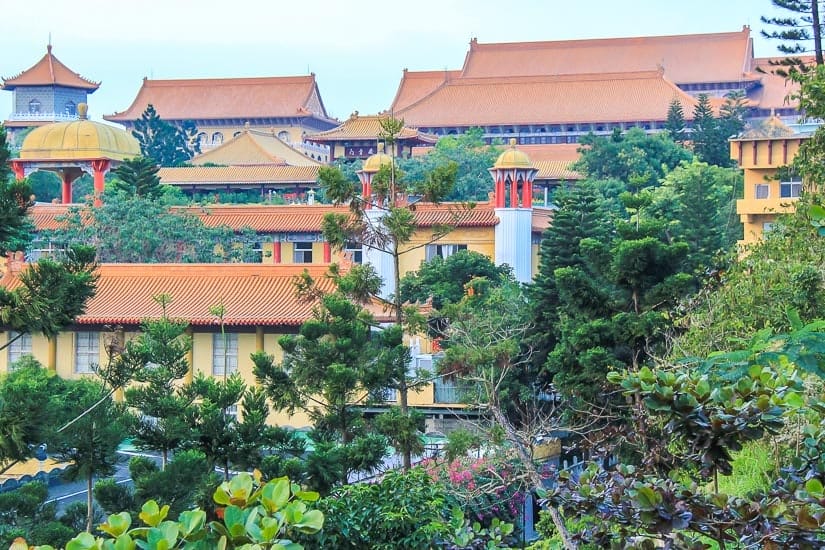
Here I will describe Foguangshan Monastery, the original (older) section of Foguangshan, which remains the headquarter of the Fo Guang Shan Buddhist order. This is located to the south of the newer Buddha Museum/Big Buddha area, and includes dozens of buildings and other facilities. You can learn more about the below and other facilities on site here on the official website’s online temple tour.
You can access all the below facilities from Fo Guang Shan (佛光山) bus stop. You should budget 1-2 hours to visit the main sights mentioned below, and more if you plan to eat at the temple restaurant (see “where to eat at Foguangshan” section below).
These are the order of sights you will encounter upon arriving:
Foguangshan Cemetery (佛光山萬壽園)

As you approach Foguangshan from the 佛光山 bus stop, you will enter a gate where you see a large map, then proceed to the temple complex’s main entrance via a covered walkway. You may hardly notice because the path is covered, but right beside on the sides of a hill is the Foguangshan Cemetery.
The cemetery features row upon row of statues. It is possible to get up close to these statues from inside the temple grounds, when you visit the next two sights.
Reception Area/Visitor’s Center
Reaching the main entrance area of the temple complex, there’s a small visitor’s center, in case you have any questions. Next, proceed down the Pilgrim’s Way to reach the below two sights.
Ksitigarbha Shrine (佛光山地藏殿)

The hilltop Ksitigarbha (or “Great Vow”) Shrine is dedicated to the Ksitigarbha bodhisattva. Outside the shrine are (you guessed it!) 1000+ more statues. The shrine leads to the Big Buddha (see below).
Fo Guang Shan Great Buddha Land (大佛城)
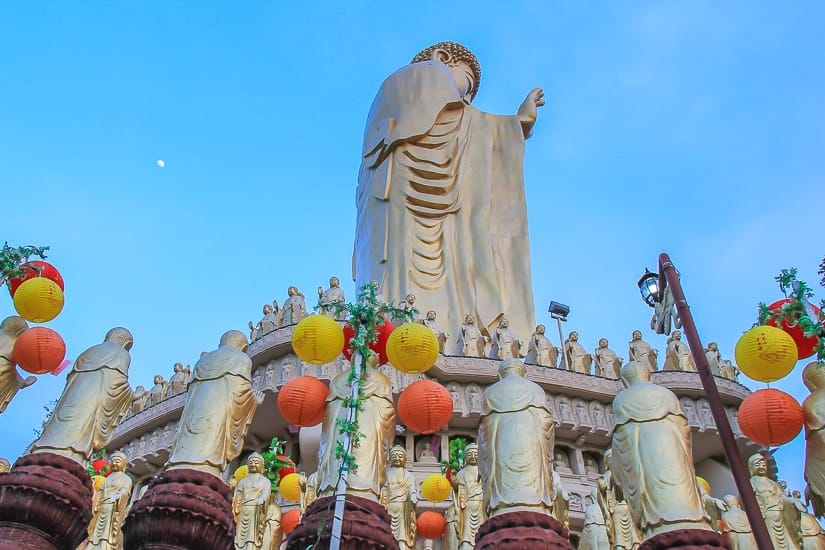
This 36-meter statue of Amitabha Buddha towers over the old Fo Guang Shan Monastery area. From here, it is also possible to access the many statues of the Foguangshan Cemetery (see above). After viewing the statue, go back down the Pilgrim’s Way, returning to the main entrance of Foguangshan. Proceed to the road just west of the Visitor’s Center to access the following sights:
Pure Land Cave (淨土洞窟)

Not marked on GoogleMaps, but you can find the Pure Land Cave just before a large staircase on the walking route just northwest of the Reception Center. The cave entrance is on the left just before the staircase. The super creepy cave is filled with all kinds of tacky imagery and weird statues that look like they were built 30 years ago and long since forgotten.
Pilgrim’s Lodge and Bamboo Garden Lodge
Visitor’s who’ve made a reservation to spend the night can proceed to the Pilgrim’s Lodge (佛光山朝山會館) or Bamboo Garden Lodge (佛光山麻竹園) to check in.
Main Shrine (佛光山大雄寶殿)

The huge Main Shrine at Foguangshan was personally designed by the founder Hsing Yun. It is 3570 meters square and houses three 7.8-meter Buddhas as well as 14,800 smaller ones in niches in the walls. The interior is truly stunning and serene.
In addition to the above attractions, there is also a Buddhist bookstore (佛光山文教廣場) and a small souvenir shop on the monastery grounds. Fo Guang Shan Tsunglin University (佛光山叢林學院) is also located in the area, but tourists aren’t meant to wander into it.
Fo Guang Shan Buddha Museum

Completed at the end of 2011, the Fo Guang Shan Buddha Museum (formerly the “Fo Guang Shan Buddha Memorial Center”) is the new shining star of Fo Guang Shan. The enormous complex eclipses the original monastery in sheer size and beauty, making the former seem dated.
The building of the Buddha Museum catapulted Fo Guang Shan from somewhat quirky southern Taiwanese attraction to visit when in Kaohsiung to one of Taiwan’s top-10 tourist attractions. Most spectacular of all is the 108-meter Big Buddha, the largest in Taiwan. The whole complex was built to house a tooth relic of the Buddha himself.
All in all, you’ll likely need at least one hour to make a quick visit, or two hours to explore everything there is to see at Foguangshan Buddha Museum.
Here are the main facilities or buildings your will encounter upon arriving:
Foguangshan Front Hall

The enormous entrance building contains some beautiful statues and has the air of an upscale Buddhist department store, complete with a Starbucks! There are several vegetarian restaurants, bakeries, and upscale Buddhist paraphernalia shops inside. The Foguangshan Memorial Hall bus stop (佛陀紀念館站) is located outside the entrance and down the road from the Front Hall.
Great Path to Buddhahood and Eight Pagodas

This is the long main path leading from the Front Hall to the Giant Buddha. It is flanked by eight towering pagodas (four on each side), as seen in the above photo.
Main Hall
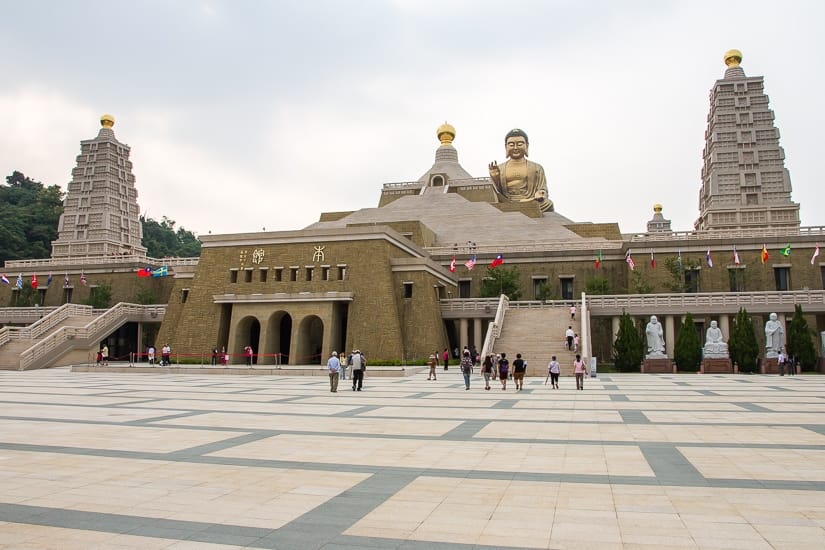
The Main Hall of Foguangshan is a domed, Indian-style stupa built mainly of stone. There is a pagoda at each corner and a golden central spire that is said to contain one million copies of the Heart Sutra. The Main Hall contains several shrines, displays and museums.
Fo Guang Big Buddha (佛光大佛)

Cast from 1800 tons of metal, the enormous seated Buddha presides over the complex and is the biggest Buddha in Taiwan. The statue itself is actually 40 meters tall, but together with its large base, it reaches a height of 108 meters.
48 Underground Palaces
Although not accessible to the public, Fo Guang Shan is amassing various valuable relics and artifacts donated from around the world and collecting them in underground palaces with the purpose of preserving memories of human civilization.
Doing a Fo Guang Shan Temple Stay
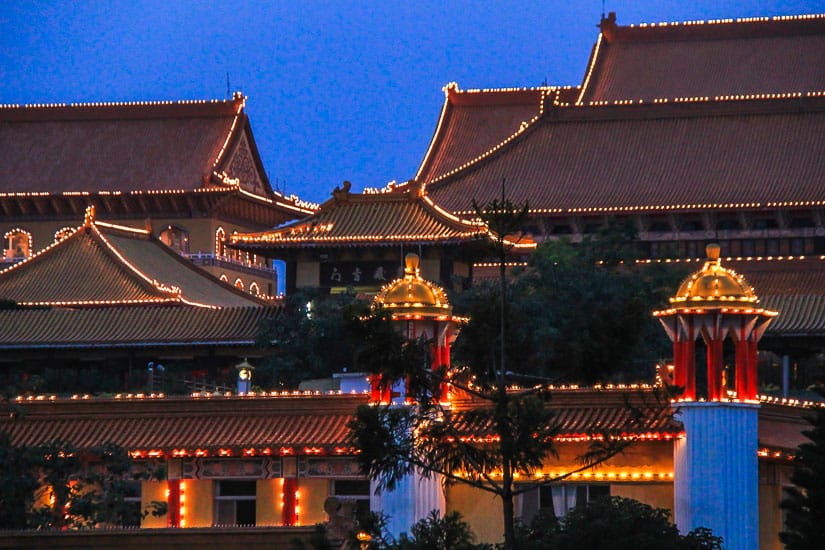
Besides numerous volunteer opportunities at Fo Guang Shan, it is possible to spend a night at the Fo Guang Shan Pilgrim’s Lodge (佛光山朝山會館) and Bamboo Garden Lodge (佛光山麻竹園).
A room for 1-4 people costs around TWD2000 per night, or a room for up to 8 people is TWD3000 per night (please double check for the current prices. You can make a reservation by calling 07-6561921, extension 8100. You can also try to email [email protected] and/or [email protected]. Only some people in the office speak English, so if one method doesn’t work, then try the other.
Note that this is located in the original Fo Guang Shan Monastery section, not in the newer Fo Guang Shan Buddha Museum. This means you’ll be able to explore the older temple grounds later in the evening, but not the Big Buddha section, which closes at 6 p.m.
I stayed overnight at Fo Guang Shan in 2010, in one of my first years in Taiwan, and before the Buddha Museum or Big Buddha was finished being built. It’s been a while, but according to more recent reviews I’ve read, the experience is still fairly similar.
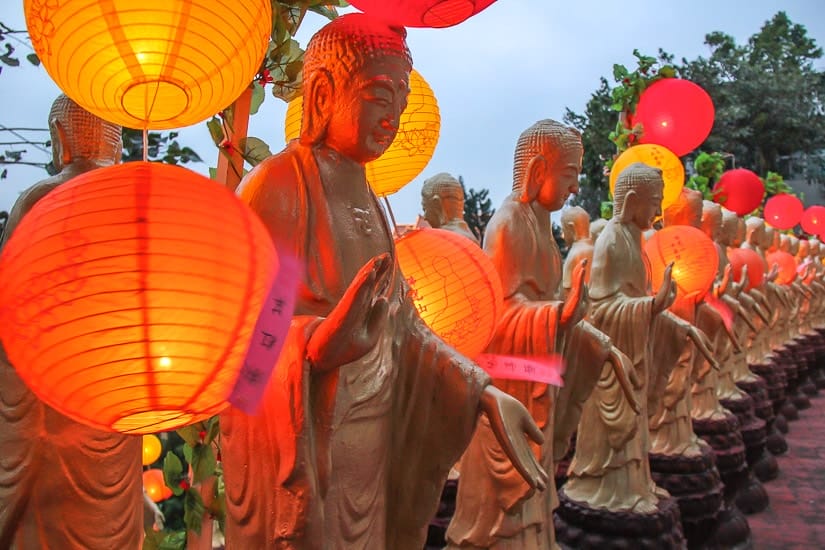
If you’re interested in doing the Foguangshan temple stay program, first and foremost, don’t expect a kind of immersive or super traditional temple experience. The rooms you stay in are like simple, modern hotel rooms (couples are fine). There is no program of meeting monks, touring the grounds, or participating in rituals like you might find at other temple stay programs in Asia (for example, read about my Beomeosa temple stay in South Korea).
Still, I really enjoyed doing a temple stay at Fo Guang Shan. My favorite part was being able to wander freely in the temple grounds after all the tourists had gone home. I felt I was the only tourist there and had it all to myself. I also got to see the grounds in the dark, which was a surreal experience. Photographers will especially enjoy this!
In the morning, there is an option to wake up extremely early to observe a ritual (I opted to sleep in). The stay also includes a Buddhist vegetarian dinner and breakfast. I remember I was also able to have a good chat with a Western man who had been living at the monastery for years, and who was able to answer many questions I had about the temple.
If you don’t intend to sleep at Fo Guang Shan, then see my guide to other places to stay in Kaohsiung.
For a more off-the-beaten-track temple stay in Taiwan, see my article on Lion’s Head Mountain in Miaoli County.
Eating at Foguangshan
When visiting Foguangshan, you certainly don’t need to worry about packing a lunch. There are loads of dining options on site, including:
Restaurants at Fo Guang Shan Monastery
Water Drop Tea House (傳燈樓滴水坊): Vegetarian hot pot and other traditional Buddhist vegetarian dishes, open 11 a.m. to 2 p.m. and 5 to 7 p.m. (closed Wednesdays)
Restaurants at Fo Guang Shan Buddha Museum
There are several vegetarian restaurants and shops in the Front Hall, including a bakery, an egg cookie stand, a mochi stall, and a Starbucks. You can also find a unique tea egg sandwich stall, as well as a food stall doing cheap, simple local Taiwanese dishes outside the back side of the front hall, with tables for seating.
There are several more vegetarian restaurants within the temple grounds (see all of them here or this full list I have compiled:
- Man Xiangyuan Restaurant (滿香園餐): Opposite the main entrance, just outside the temple but owned by it, and connected to a 2-story souvenir shop.
- 小品店滴水坊: Simple local meals, just outside Front Hall.
- Tushita Heaven (兜率天): Just outside the vehicle entrance gate. Light meals and snacks.
- Hi-lai (漢來) Luxurious restaurant in entrance hall
- Hsiang Guang Ting Restaurant (香光亭 滴水坊) Full restaurant. Closed on Thursdays.
- Pilgrims Lodge (朝山會館) Open at meal times every day.
- Transmission of the Lamp Restaurant (傳燈樓 滴水坊) Closed Thursdays
- Art Gallery Teahouse (美術館 滴水坊)
- Big Dining Hall (大齋堂): Formal eating with monastics, only recommended with a guide
- Garden Tea House (香花)
How to get to Fo Guang Shan Monastery
The easiest way to get to Foguangshan and avoid transportation hassles is to take a half-day Foguangshan tour or full day Kaohsiung tour that includes a stop there.
You should budget 30 minutes to an hour for getting to Fo Guang Shan from Kaohsiung, but of course it’s going to depend on what part of Kaohsiung you’re coming from.
When arriving at Foguangshan, there are two stops. One is Fo Guang Monastery (stop name: 佛光山) and the other is the newer Fo Guang Shan Buddha Museum & Big Buddha (stop name: 佛陀紀念館). Different buses approach Foguangshan from different directions, so they may stop at either of these stops first.
If you plan to visit both, you can hop on any passing bus between them (but you may be waiting a while), or you can walk (10 minutes). Note that it is slightly uphill going from Buddha Museum to the older Monastery. So if you plan to walk between the two, it’s easier to start at the older monastery, then walk down to the Buddha Museum.
You should be able to swipe an EasyCard for all these buses, but I’d recommend having some change handy just in case. Also, since the buses don’t come too often, it’s a good idea to check the schedules ahead of time.
From Zuoying (Kaohsiung’s HSR station)
If you’re coming directly from Taipei or other major cities on the west coast of taiwan on the High Speed Rail, you can get off at Zuoying (the terminal station) and take EDA bus 8501 (make sure you take the 8501 Foguangshan line (佛光山線), not the 8501 Zuoying Line (高鐵左營線).
The bus costs TWD65 and takes about 45 minutes. You can see the departure times here (but make sure to click on 8501佛光山線). This bus seems to stop at Fo Guang Shan first then Buddha Museum. This bus also passes E-Da Theme Park on the way to Foguangshan (see below).
The monastery also offers a shuttle bus from the HSR station called Harvard Express (哈佛快線). It costs TWD70, and the schedule is here. When it says “Fengshan”, it means “Fo Guang Shan”. The bus seems to stop at Buddha Museum first then Fo Guang Shan Monastery.
Money-Saving Tip – If you’re planning to arrive in Kaohsiung by HSR (High Speed Rail) from Taipei, book your tickets here on Klook to get a discount. Here’s how the tickets work.
From Central Kaohsiung
From Kaohsiung Railway Station, you can take Kaohsiung bus 8010 (TWD 12) from the bus stop in front of the station. You can view the route map here. Click on 時刻表 to see the departure times. Note that the bus only departs Kaohsiung at 6:20 a.m., 6:50 a.m., or 12:55 p.m. The bus takes an hour to arrive. Keep in mind that Fo Guang Monastery doesn’t open until 8 a.m., and Buddha Museum opens at 9 a.m.
The same bus has more frequent departures from Fengshan (鳳山客運站 , the second column). You can get to Fengshan train station by hopping on the regular train (TRA) from Kaohsiung station. The bus station is right outside the train station.
When arriving at Fo Guang Shan, the bus stops at Fo Guang Shan first then Buddha Museum.
Alternatively, you can ride the KMRT to Zuoying and follow the directions above for Zuoying to Foguangshan.
Other Places to Visit Around Foguangshan
When you’re in the area of Foguangshan, there are a few other notable attractions nearby that you can possibly combine into your Foguangshan day-trip.
Meinong (美濃)

Meinong is a small Hakka village in the countryside. The Hakka are a formerly nomodic people originating in Central China who today make up 15-20% of the population of Taiwan. They mostly live in Hsinchu and Miaoli, Northern Taiwan, but Meinong is one of the most well known Hakka communities in the South.
You can visit Meinong to sample their hearty cuisine and to see (or buy) one of the traditional bamboo and rice paper umbrellas for which the village is famous. I still have a beautiful Hakka umbrella that I bought at the Meinong Folk Village (美濃民俗村) displayed in my living room!
Getting from Foguangshan to Meinong isn’t so easy, unfortunately. By public transportation, you’ll have to ride bus 8101 going north to Cishan (Cishan or 旗山)’s Kaohsiung Bus Qi Shanbei Station (高雄客運旗山北站), then transfer to a taxi or bus E25 for the final short leg. Budget about 2 hours to get there.
When I went from Foguangshan to Meinong, I asked the reception at Foguangshan to arrange a private transfer for me. It cost a fair bit, but only took 30 minutes to arrive.
Moon World Landscape Park (月世界地景公園) is another cool place worth visiting near Qishan.
E-Da Theme Park (義大遊樂世界)
E-Da is one of the largest theme parks in Taiwan. If you’re interested in visiting, you can buy heavily discounted tickets here on Klook. You can take 8501 bus from Foguangshan back towards Zuoying HSR station and get off at E-Da World Station to reach it.
Final Thoughts on Visiting Fo Guang Shan Taiwan
If you have any preconceptions about what a Buddhist temple should look like, then they may be destroyed when you visit Foguangshan. Taiwan’s largest monastery is flashy, over-the-top, grand in scale, and tacky at times. It may leave you wondering what the Buddha himself would have though. Would he stop in for a latte after his visit?
But Foguangshan is what it is, and the organization has done a commendable amount of charity work, for what it’s worth. One thing that’s for sure is that the Fo Guang Shan temple grounds and Big Buddha are truly impressive sights that really should be included on any Taiwan travel itinerary.
And if you’re like me, and enjoy spending more time taking in and photographing such places, then why not spend the night at Fo Guang Shan, too?



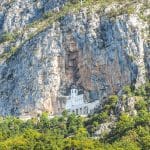
Thanks for this comprehensive post on Foguangshan. It really convinced me to make it part of my itinerary during my recent trip to Taiwan. I did a two night stay there and it was a calming experience to be able to take in all that the temple has to offer at a relaxing pace. I loved the serenity of the temple grounds in the early mornings and after dark too. Might I add though, if taking public transport to the temple, do not bring a huge luggage. Hilly terrain and large temple grounds and public bus don’t go well w luggage. thanks again for the post!
Glad to hear you had a nice stay. And thanks for the tip! The monastery grounds are huge, so that makes sense. And the sleeping area is far away from the Buddha Museum and statue area.
which accommodation would you recommend the Bamboo Lodge or the Pilgrims Lodge, or do you get a choice?
Sorry, it has been too long since I stayed there, so I don’t remember the difference or which one I stayed in. I think they are just two adjacent buildings and it depends which type of room you need. But you can find out by contact them via the email I provide in the article.